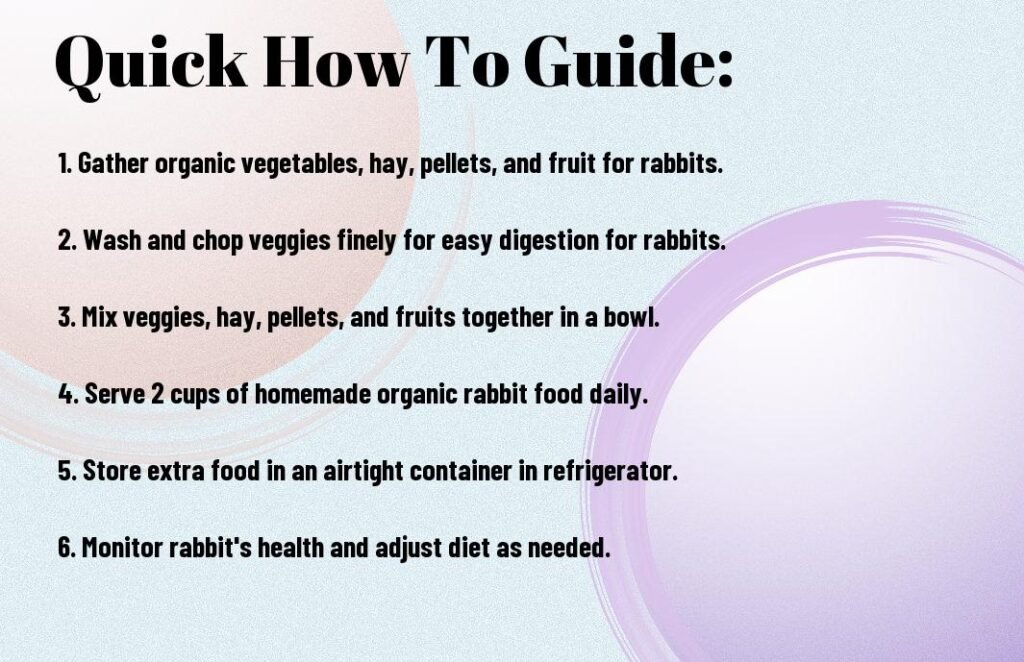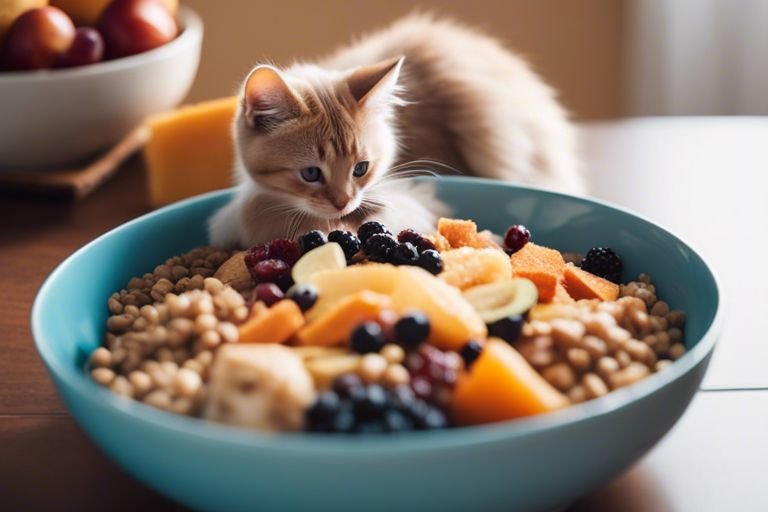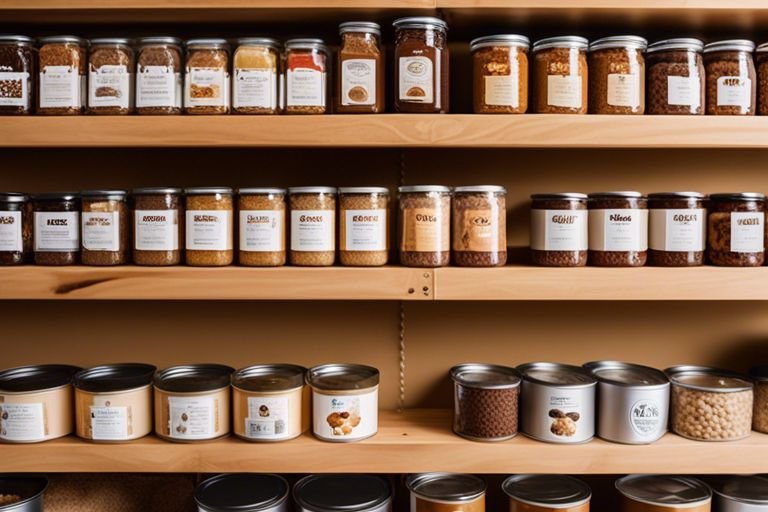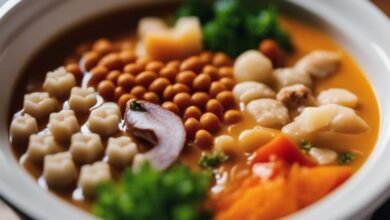How To Make Your Own Organic Rabbit Food At Home

Organic rabbit food is the best way to ensure your furry friend is eating healthy. There’s nothing more satisfying than knowing exactly what your bunny is consuming. By making your own organic rabbit food at home, you can be sure your bunny is getting all the nutrients it needs without any harmful additives. Not only is it easy and cost-effective, but it’s also a fun way to show your rabbit some extra love. Follow these simple steps to create a healthy and delicious diet for your beloved pet.
Key Takeaways:
- Choose high-quality ingredients: Select organic grains, hay, vegetables, and herbs to ensure your rabbit’s diet is nutritious and balanced.
- Include a variety of foods: Incorporate different types of vegetables, herbs, and hay to provide a diverse range of nutrients for your rabbit.
- Avoid toxic plants: Be aware of which plants are toxic to rabbits, such as avocado, tomato leaves, and potatoes, and avoid including them in your homemade organic rabbit food mix.
- Consult with a vet: Before making any changes to your rabbit’s diet, it is important to consult with a veterinarian to ensure that the homemade food meets your rabbit’s specific nutritional needs.
- Gradually introduce new foods: Introduce new foods slowly to prevent digestive issues and monitor how your rabbit reacts to each ingredient in the homemade food mix.

Understanding Rabbit Nutrition
A well-balanced diet is imperative to keep your pet rabbit healthy and happy. In terms of creating your own organic rabbit food at home, understanding rabbit nutrition is key. By familiarizing yourself with the nutritional requirements of rabbits, you can ensure that your furry friend is getting all the necessary nutrients to thrive.
Factors to Consider When Choosing Ingredients
An important factor to consider when choosing ingredients for your rabbit’s food is the freshness and quality of the produce. Opt for organic ingredients whenever possible to minimize the exposure to pesticides and other harmful chemicals. Additionally, consider your rabbit’s individual dietary needs and preferences, such as any food sensitivities or allergies they may have.
- Choose a variety of fresh vegetables and herbs to provide a wide range of nutrients.
- Include high-fiber pellets to ensure proper digestion and dental health.
- Avoid sugary treats and opt for natural, healthy alternatives.
Though it may take some trial and error to find the perfect balance, paying attention to these factors will help you create a nutritious and delicious diet for your rabbit.
Importance of Fiber and Protein in Rabbit Diets
Choosing the right balance of fiber and protein is crucial when it comes to formulating your rabbit’s diet. Fiber is imperative for proper digestion and helps maintain a healthy gut flora, while protein is necessary for muscle growth and overall health. By including a variety of high-fiber and protein-rich foods in your rabbit’s diet, you can ensure they are getting all the imperative nutrients they need to thrive.
Understanding the importance of fiber and protein in your rabbit’s diet can help you make informed decisions when selecting ingredients for their food. Be sure to include a good mix of hay, fresh vegetables, and high-quality pellets to meet your rabbit’s nutritional needs.
Common Nutritional Deficiencies in Rabbits
An imperative part of understanding rabbit nutrition is being aware of common nutritional deficiencies that can arise in pet rabbits. From lack of fiber to inadequate protein intake, these deficiencies can have a significant impact on your rabbit’s health and well-being. By learning to recognize the signs of nutritional deficiencies, you can take proactive steps to address them and ensure your rabbit stays happy and healthy.
Rabbits that are not getting enough fiber may experience digestive issues, such as constipation or diarrhea. Similarly, a lack of protein in their diet can lead to muscle weakness and other health problems. By being attentive to your rabbit’s diet and behavior, you can catch these deficiencies early and make the necessary adjustments to their food to meet their nutritional needs.

Selecting the Right Ingredients
Tips for Choosing Fresh and Organic Produce
Little furry friends like rabbits need a diet that consists of fresh and organic produce to stay healthy and happy. When choosing ingredients for your homemade organic rabbit food, you want to make sure you choose the best quality fruits and vegetables. Look for produce that is free from pesticides and other harmful chemicals. You should also opt for a variety of colors to ensure your rabbit gets a good mix of nutrients.
- Choose leafy greens like kale, parsley, and dandelion greens.
- Select high-fiber vegetables such as bell peppers, broccoli, and carrots.
- Include fruits like apples, bananas, and berries as occasional treats.
After you have gathered your fresh and organic produce, make sure to wash them thoroughly before serving them to your rabbit. Properly storing any leftovers in the refrigerator will help keep them fresh for longer.
Grains and Legumes: What to Use and What to Avoid
If you decide to include grains and legumes in your homemade rabbit food, it’s vital to choose the right ones. Some grains and legumes can be too starchy or difficult for your rabbit to digest, so you’ll want to avoid those. Opt for whole grains and legumes that are high in fiber and protein to provide your rabbit with the necessary nutrients.
For instance, you can use oats, barley, and lentils in moderation to add variety to your rabbit’s diet. Avoid grains like wheat and legumes like soybeans, as they may not be suitable for your rabbit’s digestive system.
Hay: The Foundation of a Healthy Rabbit Diet
Assuming you are already familiar with the importance of hay in a rabbit’s diet, you will know that it is the foundation of a healthy meal plan for your furry friend. Hay provides vital fiber that helps with digestion and prevents gastrointestinal issues. Make sure to offer a variety of hays, such as timothy hay, orchard grass, and oat hay, to keep your rabbit interested in eating.
Right before serving, check the hay for any signs of mold or dust, as these can be harmful to your rabbit’s health. Ensuring your rabbit has access to fresh hay throughout the day will help mimic their natural grazing behavior and keep their teeth healthy.
Preparing Ingredients for Your Rabbit Food Mix
How to Dry and Store Fresh Herbs
All you need for this process is your fresh herbs of choice and a clean, dry cloth. Cut the herbs from your garden or purchase them at the grocery store. Rinse them thoroughly to remove any dirt or residue. Then, pat them dry with a cloth. Once the herbs are clean and dry, you can either air dry them by tying small bunches together and hanging them in a dry, well-ventilated area, or use a dehydrator for faster results. Store the dried herbs in airtight containers in a cool, dark place to preserve their freshness.
Roasting and Grinding Grains for Optimal Nutrition
To roast grains for your rabbit food mix, spread them out evenly on a baking sheet and roast them in the oven at a low temperature until they are golden brown and fragrant. Let them cool completely before grinding them into a fine powder using a blender or food processor. Grinding the grains will make it easier for your rabbit to digest and absorb the nutrients. You can store the roasted and ground grains in a sealed container in a cool, dry place for future use.
The process of roasting and grinding grains not only improves digestion but also enhances the flavor of the grains, making them more appealing to your rabbit. By customizing the grains in your rabbit food mix, you can ensure that your pet is getting a well-rounded diet that meets their nutritional needs.
Preparing Fruits and Vegetables for Rabbit Consumption
The best way to prepare fruits and vegetables for your rabbit is by thoroughly washing them to remove any pesticides or residues. Chop them into small, bite-sized pieces that are easy for your rabbit to eat. You can mix a variety of fruits and vegetables to create a colorful and nutritious meal for your pet. Remember to remove any seeds, pits, or stems that may be harmful to your rabbit before serving.
While fruits and vegetables are an vital part of your rabbit’s diet, it’s important to introduce new foods gradually to avoid upsetting their digestive system. Start with small amounts and monitor how your rabbit reacts to each new food. This will help you determine which fruits and vegetables are well-tolerated and which ones should be given in moderation.
Preparing Ingredients for Your Rabbit Food Mix
By preparing your own organic rabbit food mix at home, you have full control over the quality and freshness of the ingredients. This ensures that your rabbit is getting a healthy and balanced diet that promotes their overall well-being. Taking the time to prepare and store ingredients properly will make it easy for you to provide nutritious meals for your furry friend on a daily basis.

Creating a Balanced Rabbit Food Mix
How to Calculate the Right Ratio of Ingredients
To ensure that your homemade organic rabbit food provides all the necessary nutrients, you need to calculate the right ratio of ingredients. Start by determining the required percentages of protein, fiber, carbohydrates, and fats in your rabbit’s diet. Consult with a veterinarian or a rabbit nutritionist to get accurate recommendations based on your rabbit’s specific needs. Once you have these percentages, you can then calculate the amount of each ingredient needed to meet these requirements.
Tips for Mixing and Blending Ingredients
With the right proportions of ingredients in hand, it’s time to mix and blend them together to create a well-balanced rabbit food mix. Make sure to use fresh, organic ingredients to ensure the best quality for your furry friend. You can mix the ingredients by hand or use a food processor to create a finer texture that rabbits can easily consume. Adding a small amount of water to the mix can help bind the ingredients together and make it more palatable for your rabbit.
- Ingredients should be finely chopped or ground to ensure easy digestion.
- Recognizing any allergies or sensitivities your rabbit may have is crucial when selecting and mixing ingredients.
Factors to Consider When Creating a Customized Mix
When creating a customized rabbit food mix, there are several factors you need to take into account to ensure your rabbit’s nutritional needs are met. Consider your rabbit’s age, weight, activity level, and any specific health conditions when selecting ingredients and determining portion sizes. Additionally, think about any dietary preferences your rabbit may have to tailor the mix to their liking.
- After creating a new mix, monitor your rabbit’s health and weight to ensure it is well-received and meets their nutritional requirements.
Adding Supplements and Treats
How to Choose Healthy Supplements for Your Rabbit
Many rabbit owners choose to supplement their pet’s diet with vitamins and minerals to ensure they are getting all the nutrients they need. While it’s important to consult with your veterinarian before adding any supplements to your rabbit’s diet, some common ones include hay-based pellets, vitamin C, and probiotics. Make sure to choose supplements specifically formulated for rabbits and avoid those that contain added sugars or artificial ingredients.
Tips for Making Your Own Rabbit Treats
While store-bought treats can be convenient, making your own treats at home can be a healthier option for your rabbit. You can use ingredients like fresh fruits (in moderation), vegetables, and herbs to create delicious snacks for your bunny. Some popular DIY rabbit treat recipes include banana oat cookies, apple and carrot sticks, and herb bundles. By making your own treats, you can control the quality of ingredients and avoid any harmful additives.
- Use organic ingredients whenever possible to minimize exposure to pesticides and chemicals.
- Avoid giving your rabbit treats high in sugar or fat, as these can lead to health issues such as obesity and dental problems.
- Recognizing your rabbit’s favorite treats can help you tailor future recipes to their preferences.
Factors to Consider When Introducing New Foods
Healthy rabbits have sensitive digestive systems, so it’s important to introduce new foods gradually to avoid upsetting their stomach. If you’re adding a new food item to your rabbit’s diet, do so in small quantities at first and monitor their behavior and digestion for any adverse reactions. Pay attention to any changes in their appetite, stool consistency, or energy levels, as these can indicate if the new food is well-tolerated.
- Assume that all new foods should be introduced slowly over a period of one to two weeks to allow your rabbit’s digestive system to adjust.
- If you notice any negative reactions to a new food, such as diarrhea or lethargy, remove it from their diet immediately and consult with your veterinarian.
Choose
By choosing the right supplements and treats for your rabbit, you can help ensure they maintain a balanced and healthy diet. Always prioritize your rabbit’s well-being by consulting with a veterinarian before making any significant changes to their diet. Remember to introduce new foods slowly and observe your rabbit’s response to ensure they stay happy and healthy.

Storing and Serving Your Homemade organic Rabbit Food
How to Store Your Rabbit Food Mix to Maintain Freshness
Unlike store-bought rabbit food, your homemade organic rabbit food mix does not contain preservatives. This means you need to take extra care to store it properly to maintain its freshness. To do this, store your rabbit food mix in an airtight container in a cool, dry place away from direct sunlight. Make sure the container is sealed tightly to prevent moisture and pests from getting in.
Factors to Consider When Transitioning to Homemade Food
On the days you feed your rabbit, make sure to give them a variety of fresh fruits and vegetables along with their homemade food mix. This will help provide them with a diverse range of nutrients and prevent boredom with their meals. Fresh hay should always be available for your rabbit to nibble on throughout the day, as it is important for their digestive health.
- Fruits and vegetables should be introduced slowly into your rabbit’s diet to prevent digestive upset.
- Knowing what foods are safe and toxic for rabbits is crucial to ensure their well-being.
Tips for Feeding Your Rabbit a Varied Diet
Freshness is key when it comes to serving homemade rabbit food to your furry friend. A diet full of fresh, organic ingredients will not only provide optimal nutrition but also enhance your rabbit’s overall well-being. Keep a close eye on any changes in your rabbit’s behavior or digestion when transitioning to homemade food to ensure they are adjusting well.
- Transitioning your rabbit to homemade food may take time and patience.
- Perceiving your rabbit’s preferences and monitoring their health throughout the transition process is important.
To wrap up
Conclusively, making your own organic rabbit food at home can be a rewarding and healthy option for your furry friend. By using fresh, natural ingredients, you can ensure that your rabbit is getting all the nutrients it needs without any harmful additives. Not only is it a cost-effective solution, but it also allows you to have full control over what goes into your pet’s diet. With a little bit of research and effort, you can create a balanced and nutritious meal plan that will keep your rabbit happy and healthy.
FAQs
Q: Why should I make my own organic rabbit food at home?
A: Making your own organic rabbit food at home ensures that you know exactly what ingredients are going into your rabbit’s diet, allowing you to control the quality and freshness of the food.
Q: What are some key ingredients to include in homemade organic rabbit food?
A: Key ingredients to include in homemade organic rabbit food are fresh vegetables such as leafy greens, carrots, and bell peppers, as well as high-fiber pellets, hay, and small amounts of fruits.
Q: How can I ensure my homemade organic rabbit food provides all the necessary nutrients?
A: To ensure your homemade organic rabbit food provides all the necessary nutrients, it is important to include a variety of vegetables, pellets, and hay in their diet. You can also consult with a veterinarian or rabbit nutritionist to create a balanced diet plan.
Q: Can I make large batches of homemade organic rabbit food and freeze it?
A: Yes, you can make large batches of homemade organic rabbit food and freeze it for later use. This can help save time and ensure that your rabbit always has fresh food available.
Q: Are there any foods that are harmful to rabbits that I should avoid when making homemade organic rabbit food?
A: Yes, there are certain foods that are harmful to rabbits and should be avoided when making homemade organic rabbit food, such as chocolate, avocado, onions, and iceberg lettuce. Be sure to research and avoid any foods that are toxic to rabbits.




